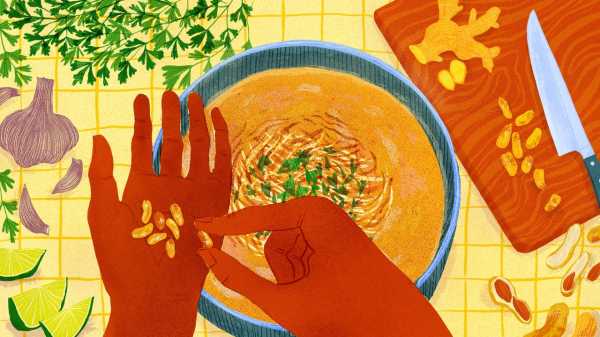
It would be hard to find a more devoted champion of the peanut than the agricultural scientist George Washington Carver. Born into slavery in Missouri around 1864, Carver studied at Iowa State University and then taught at the Tuskegee Institute, where he would spend much of the rest of his life learning to repair the environmental damage wrought by intensive cotton farming. He found that sweet potatoes and peanuts could replenish the depleted Southern soils, as both are nitrogen-fixing plants. By growing and regularly rotating these crops, farmers could begin to bring life back to the land.
But where Carver’s genius really shone wasn’t so much as an inventor but as a thrifter par excellence. Farmers who sowed their fields with peanuts found their soils enriched, sure, but were left with more peanuts than they knew what to do with. Enter Carver and his 1916 missive, “How to Grow the Peanut and 105 Ways of Preparing It for Human Consumption,” which advises readers on everything from the best soil type for growing peanuts with a light-colored shell to the merits of peanut-plant hay. Carver supplies recipes for peanut candies, cakes, wafers, fudge, ice cream, cookies, and bread, as well as peanut omelettes, macaroni and cheese, salad, cream cheese, and no fewer than five distinct ways to make peanut soup. Here, a cook will find every dish that can be improved with a handful of peanuts, and many more that can’t. Four years after the bulletin’s publication at an industry convention, Carver exhibited a hundred and forty-five novel uses for peanuts and their by-products in a talk that he titled, understating things somewhat, “The Possibilities of the Peanut.”
The journalist Jori Lewis recounts some of the past and parallel lives of the peanut plant in her recent book, “Slaves for Peanuts.” The product of a dazzlingly unlikely genetic accident—Lewis describes it as a botanical “one-night stand”—Arachis hypogaea first laid down roots in the eastern foothills of the Andes some ten thousand years ago. On the surface of things, there’s little to distinguish it; for most of its life a peanut plant is a bundle of elliptical leaves on a squat, featureless bush. If you are lucky enough to catch it in the act, you can see the plant explode with small mustard-yellow flowers. After this brief flash of light, stems begin to sprout, not skyward but down into the soil. At the end of these filaments and away from prying eyes, a constellation of peanuts grows—wrinkled, tan-brown protuberances in the dirt.
Once shelled, peanuts bear treasure: they’re rich with oils and proteins, and they are as easy to eat as they are to replant. Above all, they’re versatile. As Carver put it, “I doubt if there is another foodstuff that can be so universally eaten, in some form, by every individual.” Lewis writes that by the time Europeans arrived in the Americas, the peanut was maní to the Taíno people in the Caribbean, manobi to the Tupi, tlacacauatl (earth cacao) to the Nahua, and inchic in parts of Peru. The crop wouldn’t become popular among Europeans for some time, but it found a foothold in the parts of West Africa where the French, Spanish, British, and Portuguese established trading outposts and colonies. There, it found a ready market among people already familiar with the native groundnut, which is similar in appearance. The peanut even came to commandeer the groundnut’s name, the two crops confused by European traders. We don’t know exactly when peanuts arrived on West African shores, Lewis writes. “The why, though, we can intuit; they were tasty little things.”
“Peanut” is something of a misnomer; the plant is really a legume, more closely related to lentils than to tree nuts, although that’s not how it tends to be used in Western cuisine. The plant has countless names and as many purposes. And, as “Slaves for Peanuts” makes clear, the crop’s commercial history is no less slippery. Lewis argues that the commercial peanut trade in West Africa was made possible by loopholes in French antislavery laws; by the late eighteen-hundreds, slavery was no longer legal in the French colonies, but exceptions were made in the Kajoor Confederation, for example, which was still under “soft occupation.” There, colonial officials presided over a burgeoning and profitable trade.
Though the peanut has made its way around the world, it still hasn’t really made a notable impression on the culinary canon of the U.K., where I live. The peanut dishes of the colonized Caribbean or West Africa haven’t found a place in the mainstream in the same way as peanut butter, with peanut-eating inspiration drawn primarily from North American snacking culture. The plant’s versatility, as Carver imagined it, has been largely lost here. Despite ostensibly knowing better, I tend to underestimate peanuts myself: I open and close the kitchen cupboard doors, willing inspiration to come while picking at them until I become too full to eat dinner, anyway.
It’s a shame, because I do know how to cook with peanuts, as do a great many people whose food cultures are wise to the plant’s possibilities. Peanuts are artfully deployed in chutneys, curries, stews, and sauces from Indonesia to Senegal, India, and the Philippines. For my part, I’ve made salads of peanut with watermelon and sumac, fries dunked in garlic-scented satay sauce, and more variations on my aunt’s Ghanaian groundnut stew than I can remember. I know that I can grind peanuts, salt, and delicately spice them to make Nigerian yaji, seasoning beef or vegetables to be grilled.
Bringing Carver to mind, I’ve lately made a point of incorporating peanuts in my cooking, bringing them out of the snack zone and into the light. “Save everything,” Carver was fond of saying. “From what you have, make what you want.” For a recent dinner, I gouged the eyes from some potatoes that had been lingering in the cupboard depths for a little too long, and blended peanuts with water. Rummaging in the fridge, I found an onion on the turn and some ginger, which I threw into a pan with garlic and spices, evoking some of the flavors of the West African peanut soups I know so well. Into the pan went the potatoes and the peanut mixture. While this simmered, I prepared a garnish borrowed from another peanut soup, Bolivian sopa de maní, which is traditionally topped with fried potato. The result is an unlikely meeting of two very different soups from two continents, anchored by an ingredient that, however improbably, I can always find in my kitchen cupboard.
Peanut-and-Potato Soup
This dish gives me enormous comfort and, importantly, puts paid to the idea that a soup is a “light” meal.
Serves 2
Ingredients
For the soup:
100 g (approximately ¾ cup) dry-roasted peanuts
1 Tbsp. peanut or sunflower oil
1 shallot, or ½ a small onion, finely diced
1–1½-inch chunk of ginger, minced
3 garlic cloves, minced
Salt, to taste
½ Tbsp. tomato paste
1 tsp. sweet paprika
¼ tsp. ground cumin
1 medium-large potato, peeled and cut into ½-inch dice
½–1 chicken bouillon cube, depending on whether your peanuts are salted
1 Tbsp. lime juice
½ Tbsp. light-brown sugar
To garnish:
Peanut or sunflower oil, for shallow frying
1 small potato, peeled and coarsely grated
1 Tbsp. finely minced parsley
Directions
1. Start by soaking the peanuts in 150 ml. (approximately ⅔ cup) freshly boiled water. Set to one side.
2. Heat the cooking oil in a medium saucepan over medium-low heat and add the chopped shallot, ginger, garlic cloves, and a pinch of salt. Cook, stirring regularly, for 10 to 12 minutes, until the shallots are well softened. Don’t let the mixture brown.
3. Add the tomato paste, paprika, and cumin to the pan, stir well, and cook for 1 to 2 more minutes. Add the potato to the pan along with 425 ml. (approximately 1¾ cups) of water and your bouillon cube. Bring to a simmer, then cook gently for 10 minutes.
4. Use a blender to process the soaked peanuts until you have a smooth puree. Add to the pan along with the lime juice and brown sugar, adding extra juice, sugar, or salt to taste. Simmer over low heat for another 8 to 10 minutes, then blend until smooth. Add a splash more water for a lighter texture, if you want.
5. Wash the grated potato for the garnish in a couple of changes of cold water. When the water runs pretty much clear, drain the potato and dry on a kitchen towel.
6. Heat the oil for frying in a skillet—you’ll need about a ½ inch of oil in the pan—over medium-high heat. Once hot, test the oil by dropping in strands of potato: if the potato starts sizzling as soon as it hits the oil, it’s hot enough. Add the potato and stir briefly to separate the strands, then fry for 3 to 5 minutes, watching it like a hawk. It’s ready when golden brown, so be prepared to take it off the heat either sooner or later than anticipated, depending on how it’s doing. Remove with a slotted spatula and drain the strands on a kitchen towel.
7. Garnish each bowl of soup with a heap of crisp, fried potato strands and a little parsley. ♦
Sourse: newyorker.com






